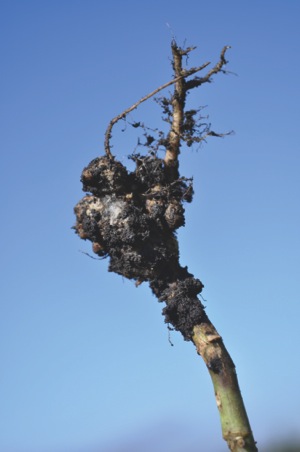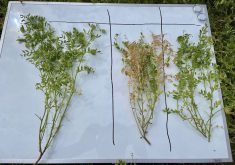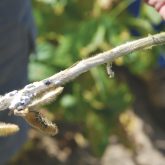Crops diseases are always a risk for grain growers. Be it rust in the 1950s, fusarium in the 1990s or clubroot today, it seems there’s always a new pestilence lurking just around the corner.
Country Guide spoke to crop disease specialists from the three Prairie provinces late this fall about what they saw in the field during 2014, and lessons that should be drawn for next year.
You can’t predict tomorrow based on what happened yesterday, particularly when it comes to something as variable and weather dependent as crop diseases. But you can see the large trends developing, and get a better sense of the looming challenges.
Read Also

Sensing the soil: Root cell research finds ‘stress hormone’
Research into how root cells react to soil stressors could help plants better adapt to changes in their climate.
Maybe you can even get just a bit better prepared this time around.
Fusarium
If there was a headline story for growers across the West in 2014, it was the return with a vengeance of fusarium head blight.
This isn’t a new foe for growers, of course, but it is the first time in a few years that it’s been a major widespread problem. Why? Well, if the three rules of real estate are location, location and location, the three rules of fusarium are timing, timing and timing.
In this case, says Manitoba Agriculture, Food and Rural Initiatives disease specialist Holly Derksen, it’s the timing of the winter wheat crop.
“It was big this year in winter wheat — the spring wheat was not as bad,” Derksen says. “In the winter wheat we saw some severe damage, because everything just lined up right as the winter wheat was starting to flower.”
Alberta’s Mike Harding saw much the same pattern farther west, saying the diseased material from decaying stubble began producing spores early in the season, just when the winter wheat crop entered the most susceptible part of its season.
Both Harding and Derksen say there were isolated problems with the spring wheat crop as well, but nothing anywhere close to as bad as the winter wheat experience.
Meanwhile in the central Prairies, conditions turned wet at just the right time to hit the spring wheat crop hard, with widespread rain that began in earnest over the Canada Day long weekend, says Saskatchewan Agriculture integrated pest management specialist Brent Flaten.
“It just went on and on, for a long time,” Flaten says. “It gave a chance for the disease to develop in the infected crop residue from previous years.”
That then produced spores which in turn infected the heads of the new crop, causing the all-too-familiar shrivelled and bleached heads, and subsequent wrinkled kernels and elevated levels of mycotoxins.
“We always talk about the disease triangle — you need to have a susceptible host crop, the inoculum and the right weather for it to develop, and this season we had all three,” Flaten says. “It really was, in a lot of ways, the perfect storm.”
The region always has susceptible crops, and the explosion of the zero-till production system over the past three decades has guaranteed the presence of inoculum, Flaten says.
“I’ve always been an advocate of zero till for its soil conservation aspect, but sometimes along with the good you get the bad, and this is one of those cases,” Flaten says. “The inoculum survives in that crop residue that’s left on the surface of a zero-till field.”
While it was a bad year, future cases of the disease depend largely on weather, so there’s no way to really know if the problem will repeat in the 2015 season.
The bigger question, instead, is whether you can find decent-quality seed for next year, since the inoculum can also be carried on the seed and infect the crop during crop establishment. It won’t cause fusarium head blight, but it will result in root rot and other early-season issues.
“I would suggest testing potential seed lots early this year, and getting them to test both total level of fusarium and what type,” Flaten says.
Type is an important question because the seedling issues are most common in the graminearum subtype, while fusarium avenaceum is also common in the province, especially in the drier western part. Both can cause fusarium head blight, but not in the season of seeding, since there is no systemic transfer.
If a grower doesn’t have enough suitable seed, they may want to consider buying new seed this year, but Flaten noted with the problem as widespread as it was this past season, there are no guarantees, so lab tests for this seed will also be important.
“Unfortunately, even certified seed growers were struggling with this disease this year,” he says.
Clubroot
Another major crop disease everyone is eyeing nervously is clubroot in canola, particularly in the region surrounding Edmonton, which is the epicentre of the outbreak in Western Canada.
Here Mother Nature delivered a stern lesson in the relentless mathematics of selection pressure, all in a short time due to the highly variable nature of the clubroot infection.
“Clubroot is what’s known as a hyper-variable infection,” Harding explains. In simple terms, that means the disease has a lot of variation within its population, vastly increasing the likelihood that some small portion of the disease in any field will have naturally occurring resistance to any control measure, be it chemical or genetic resistance built within the crop itself.
It’s that second type that was introduced to Alberta about three years ago, and this season, for the first time, serious infections were reported in fields planted to these resistant varieties. Harding says the final lab analysis is still pending on the samples, but that it’s very likely the province is looking at the first case of the breakdown of genetic resistance to clubroot.
“It would appear that what we’ve seen is a shift in the field to a new pathotype,” Harding says. “It really underlines that we’re going to need all our tools — genetic resistance, rotation, and cultural practices like limiting the spread of soil — to stay ahead of a disease that can turn over the population so rapidly.”
It’s a familiar message for growers in the affected area, but one that bears repeating, since the disease continues to prove it correct at every turn. Still, it’s not necessarily a welcome message for growers who are faced with the inevitability of more complexity and higher management requirements on ever-larger farms.
One bright spot in the recent finding, however, is that the problem thus far seems localized to just one production area, meaning the vast majority of growers are unlikely to be affected next season. However, it also highlights the need for vigilance and to be actively looking for either the disease or new variants of it.
“We need to be out there really looking for it,” Harding says. “It doesn’t matter if you’ve planted a resistant variety or if you’re in an area where you think you don’t have it — you should still be looking for it.”
Finding the problem early is vastly preferable because it tends to be smaller and easier to manage, Harding says.
“It’s a much different situation if you’re dealing with a small patch rather than a full 160 acres,” he says.
It’s those preventive measures that his colleagues in the other two provinces are currently focusing on. Both Saskatchewan and Manitoba have reported their first few findings of clubroot.
In Manitoba the disease had been identified in the soil a few years ago, but 2013 saw the first identification of an infected crop in the field, leading to a testing program that found the disease in 10 rural municipalities, with no clear cluster pattern emerging.
“It’s here, it can survive here, and it could cause problems here,” Holly Derksen says. “We really need to stay ahead of the curve.”
Brent Flaten reports a similar situation in Saskatchewan, saying so far there have just been a small handful of reports. Two soil samples were found to have the disease present, one in 2008 and one in 2012. Clubroot symptoms were reported in two fields in the fall of 2011. This year the province tested 80 fields and all were found to be clubroot free.
“We haven’t been identifying it, but it might be in other areas at a level below detection,” Flaten says. “We’re telling growers to be very aware of the issue.”
If they do suspect they’ve got a problem, they should contact their agronomist, or a provincial extension specialist, to confirm the diagnosis.
Flaten says he’s most nervous about how quickly the disease overwhelmed the genetic resistance, suggesting a multi-pronged integrated approach will be key to long-term management.
“I think we do, at times, rely too much on the genetic resistance in the crops to control diseases,” Flaten says. “That can apply a lot of selection pressure to the diseases and result in the genetic resistance in the crops breaking down.”
So far breeders have been both good and lucky, keeping ahead of key diseases like blackleg and cereal rust — but he fears this won’t continue on forever. “It’s going to be a real challenge to keep clubroot out of Saskatchewan,” he says.
Aphanomyces
Aphanomyces isn’t exactly a household name yet, but with pulse crop acres rebounding, it’s definitely one growers should be aware of.
“It’s a new disease that was identified about a year and a half ago,” Flaten says. “Before that we didn’t think we had it and likely wrote off the symptoms as waterlogging and flooding.”
It’s most common in pea fields and it’s a water mould that requires wet conditions to really cause a lot of damage.
“In that way it’s kind of self-limiting and could be managed relatively easily with field selection,” Flaten says.
Alberta’s Mike Harding says it’s been found in his province as well, and he agrees that field selection is the most obvious way to go.
“If you have a poorly drained field, that might not be your best bet for pea production,” he says.
Brewing resistance
A final concern is the looming issue of fungicide resistance to both sprays and resistant varieties.
Here the most obvious parallel is herbicide resistance, and if fungicide resistance becomes a real concern, it will be for exactly the same reason — too frequent use of the same products and varieties without proper rotation.
“Rotation is key,” Derksen says. “Both rotating your crop and rotating your fungicide and your varieties to a different type.”


















